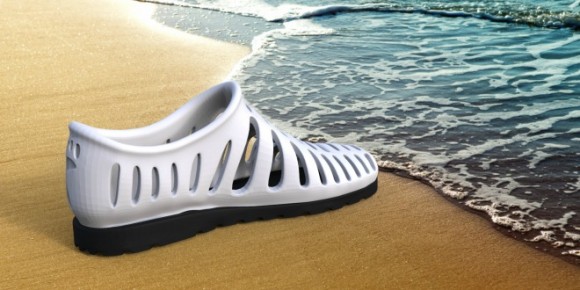 Having new shoes that you need to “break in” because they hurt your feet (or dealing with shoes that always feel uncomfortable no matter how long you wear them) will soon be a thing of the past thanks to 3D Printing. Several shoe companies, including Nike, Feetz, and United Nude, are now using 3D Printing technology to give customers shoes that are custom made for them — in the store, on the spot.
Having new shoes that you need to “break in” because they hurt your feet (or dealing with shoes that always feel uncomfortable no matter how long you wear them) will soon be a thing of the past thanks to 3D Printing. Several shoe companies, including Nike, Feetz, and United Nude, are now using 3D Printing technology to give customers shoes that are custom made for them — in the store, on the spot.
I have been covering 3D Printing for over 20 years in my Technotrends Newsletter, and at first the technology was used for rapid prototyping. Over the past few years, however, rapid advances in what I call “The Three Digital Accelerators;” processing power, storage, and bandwidth, have catapulted this technology into a tool for manufacturing finished products that include not only shoes, but also jewelry, dresses, car dashboards, parts for jet engines, jawbones for humans, replacement parts for synthesizers, and much more.
What Is 3D Printing?
When people first hear that you can manufacture something by printing it, they have a hard time visualizing it. Think of it this way: 3D printers build things by depositing material, typically plastic or metal, layer by layer, until the prototype or final product is finished. When the design is downloaded into the printer, a laser creates a layer of material and fuses it. Then it adds another layer and fuses it… and then another and another… until the object is completed.
3D printers can range from the size of a microwave oven to the size of a car. A printer that can print a house by depositing cement, layer upon layer using a printer the size of a tractor-trailer, is already in development. Prices for 3D printers range from hobbyist kits for under $1,000 to over $100,000 for industrial versions.
The Perfect Fit
What makes 3D printed shoes so enticing for consumers is that the shoes are tailored for each person’s unique feet. Few people have feet that are identical. In other words, your left foot might be slightly wider or smaller than your right foot. Because of this, finding shoes that fit both feet perfectly is rare. Additionally, because the current shoe sizing system is limited to half-integer measurements (6, 6.5, 7, 7.5, etc.), it’s only taking into account how long someone’s feet are. Finding shoes for wide or thick feet is difficult. 3D Printing solves all this.
With 3D Printing of shoes, rather than try on box after box of pre-made shoes in standard sizes, customers get photographs taken of their feet from various angles. This allows the computer to create an accurate 3D model of the person’s feet. This information is then combined with details about the customer’s height, weight, and activities they engage in. After inputting all the data, customers receive a personalized pair of shoes tailored exactly for them.
In some cases, such as with Feetz, the shoes are printed and then shipped to the customer. In other cases, like with United Nude, the shoes are printed in the store, right before the customers’ eyes.
Taking It a Step Further
Of course, this technology is not just for fashion-forward people seeking the latest trends in shoes. It also has a therapeutic application. SOLS Systems, the maker of custom, corrective orthotics, is using 3D shoe printing to make orthotic shoes that alleviate a patient’s foot pain and improve comfort. In the process, they are taking the orthotic scanning and prescription process from archaic and sterile to tech-savvy and fashionable. And because the shoes are custom made, patients experience a high level of engagement with the product, while podiatrists enjoy a higher conversion rate at the point-of-sale.
Additionally, athletic shoemaker Nike has introduced its new Nike Vapor Ultimate Cleat American football boot, which combines 3D knitting (what Nike calls its proprietary flat knitted Flyknit technology) and 3D shoe printing to give players an athletic shoe that delivers both lightweight speed and strength. By integrating 3D knitting with 3D shoe printing, Nike is giving athletes shoes that have a second-skin, sock-like fit that adapt to each individual player’s foot as well as to his style of play, helping athletes perform at their highest level. For athletics, 3D shoe printing is definitely a game changer.
Running Strong
While the majority of shoes sold today are still made the traditional way, you can be sure that 3D printed shoes will become more commonplace in the future, along with many other 3D printed products you’ll use every day. 3D Printing is advancing quickly on a global level and offers something that up until recently was impossible: On-demand, anytime, anywhere, by anyone manufacturing.
Daniel Burrus is considered one of the world’s leading technology forecasters and innovation experts, and is the founder and CEO of Burrus Research. He is the author of six books including the New York Times best seller “Flash Foresight.”
